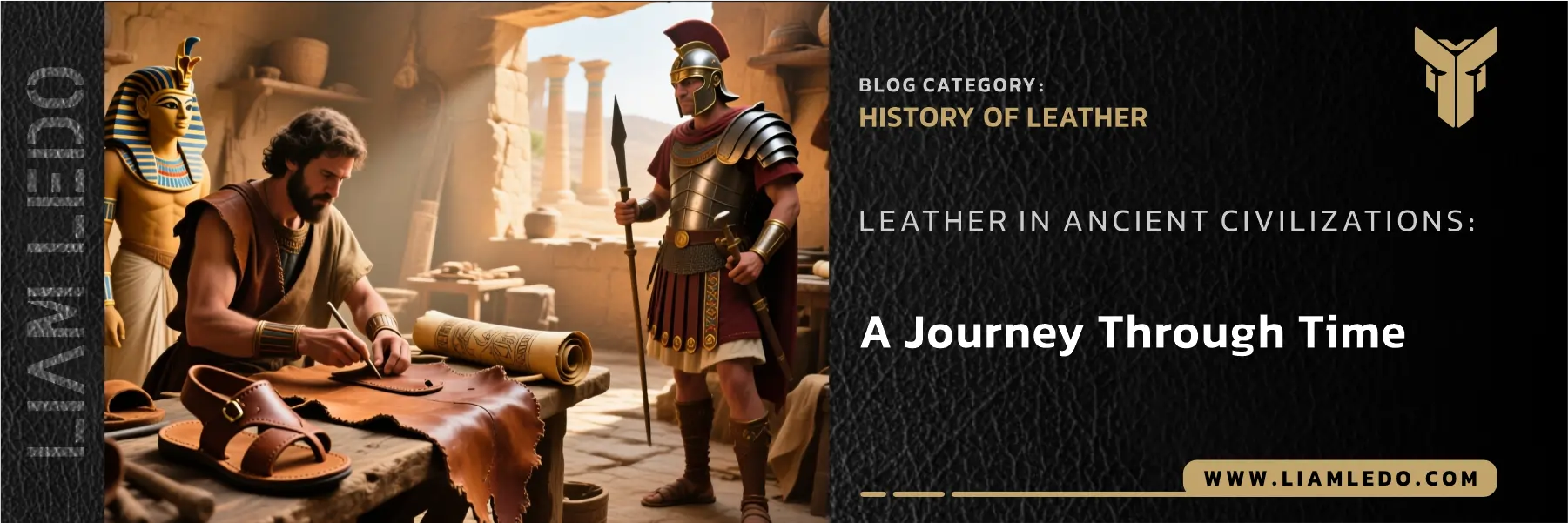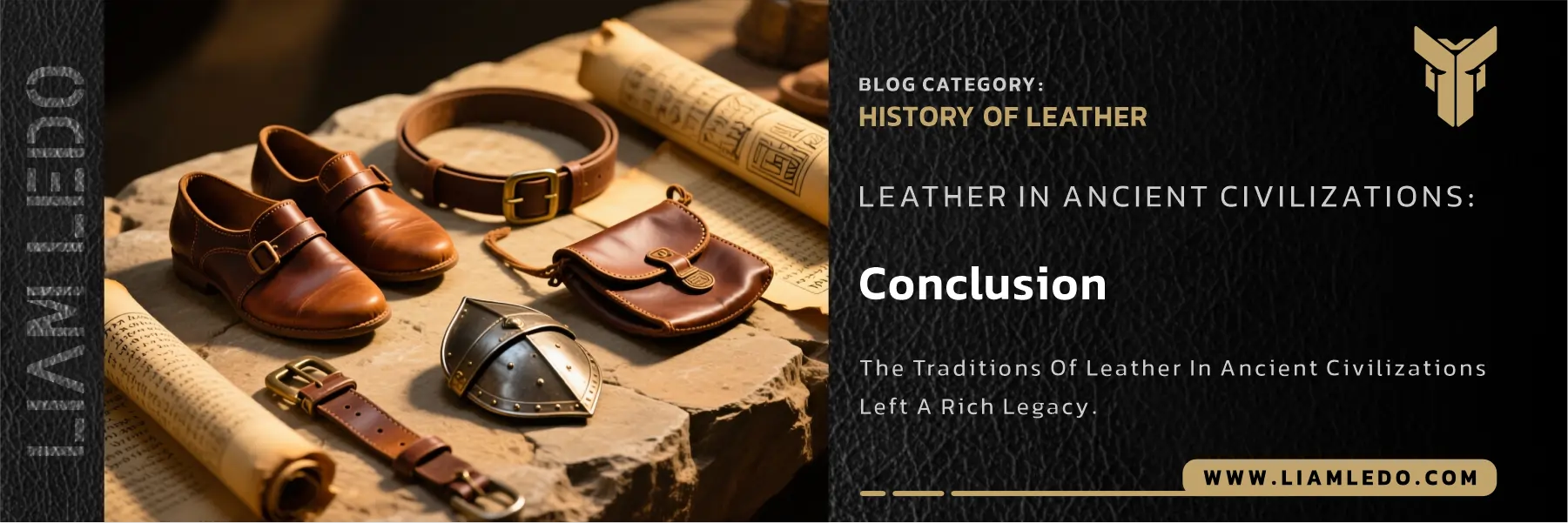
Leather in ancient civilizations shaped daily life, technology, and trade — from rugged sandals and soldier’s gear to ornate book covers and ceremonial reinforcements. Across Mesopotamia, Egypt, Greece, Rome, and the Islamic world, artisans refined tanning techniques and decorative finishes, turning animal hides into durable, versatile objects that signaled status, skill, and cultural identity.
Learn more about leather and make better choices:
1.Origins and Early Uses of Leather:
In the dawn of organized societies, humans discovered that animal hides, once properly treated, could be flexible, durable, and useful. The transformation from raw hide to wearable, workable leather was one of the great technological leaps in prehistory. The earliest evidence of leather use dates back to the Paleolithic era, but its systematic adoption emerges strongly during the Bronze Age, particularly in river valley civilizations.
In ancient Mesopotamia, for example, leather was used for sandals, belts, containers, and scabbards. The Sumerians had access to herds of goats, sheep, and cattle, and they developed rudimentary tanning methods by applying natural tannins (from tree bark or sumac) to the hides. Over time, craftsmen refined those processes to reduce rot and increase flexibility.
1.1.Leather in Ancient Egypt:
Egypt’s dry climate helped preserve organic materials, giving modern archaeologists rare glimpses into their leathercraft. Leather was widely used in footwear (such as sandals), harnesses, belts, and certain garments. It also had ceremonial and symbolic uses: leather amulets, sacred posts, and decorative strips on chariot yokes. Egyptian burial practices sometimes included leather goods placed in tombs, both for their functional and symbolic value.
One of the key tanning materials in Egypt was tannin-rich bark from acacia and other native trees. Ancient Egyptian texts (such as those on papyri) mention “soft leather” and “hardened leather,” hinting at varying techniques for different applications. High-quality leather was expensive, reserved for elites or special contexts. Lower grades served more everyday roles.
1.2.The Leathercraft of the Indus Valley and China:
Beyond Mesopotamia and Egypt, other early civilizations embraced leather. In the Indus Valley (Harappan civilization), seals and pottery often depict leather bags or pouches. Archaeological finds also point to leather shoes and stitched leather goods, suggesting that tanning and sewing techniques were well developed.
In ancient China, leather was commonly used for armor, drums, shoes, and ceremonial items. The Zhou and Han dynasties refined leatherworking arts; Chinese artisans could produce lacquered leather or leather decorated with metal fittings. They made use of plants like oak galls or gallnut-derived tannins in their tanning processes. Furthermore, leather armor (lamellar, cuirass, or laminar types) was an important military technology.
1.3.Leather in the Classical Mediterranean: Greece and Rome
The Greeks and Romans took leathercraft to new levels of organization and scale. In Greece, leather was employed in armor (such as linothorax—linen and leather composite), sandals (the famous kothornos, krepis, calceus), water containers (leather wineskins), bookbinding, and more. Greek myth and literature often reference leatherwork, implying its prestige and ubiquity.
Under the Roman Empire, leather became a massive industry. Romans manufactured boots (caligae for soldiers), saddles, harnesses, belts, book covers, bags, and even tents with leather reinforcements. Leather shoes were worn by most classes, though styles varied by status. The city of Rome boasted leather workshops called fullones or corifices, and guilds regulated leatherworkers.
Roman tanning techniques included using tannins from oak bark, pomegranate rind, and alum salts. They also discovered processes for coloring and dyeing leather, sometimes with indigo or red dyes, and for stamping or embossing decorations. Roman roads and military campaigns spurred demand for quality leather goods, causing trade in hides and finished leather to flourish across the Mediterranean and beyond.
1.4.Leather in Early Islamic and Medieval Periods:
After the decline of Rome, leather traditions survived and evolved in the Islamic world, Byzantium, and medieval Europe. In the Islamic Golden Age, leather artisans in cities like Córdoba, Baghdad, and Cairo developed extremely fine leather for book covers, polished leather panels (with tooling and gilt), and luxurious garments. The craft of marquetry leather or cuir bouilli (hardened leather) became refined in North Africa and Moorish Spain.
Trade routes such as the Silk Road and Mediterranean maritime networks enabled the flow of hides, tanning materials, dyes, and finished leather goods among Islamic, Byzantine, African, and European markets. Guilds and regulations governed leather quality and practices. The Islamic scholars also preserved and transmitted leatherworking treatises (often translated from Greek, Syriac, or Persian), contributing to continuity and innovation.
Meanwhile, in medieval Europe, tanning was often done near rivers and streams (for water supply and effluent disposal). Leather was central to everyday life: shoes, belts, gloves, saddlery, armor components (like cuirasses, greaves, vambraces), and book bindings of vellum or calf leather. Techniques such as vegetable tanning, oil tanning, and wax dressing emerged and evolved.
1.5.Techniques and Materials: Tanning, Dyeing, and Treatment
A critical dimension of leathercraft is the technical process of turning hide into leather. Across civilizations, certain core stages appear:
- Soaking and cleaning: Removing flesh, hair, and fats.
- Liming or alkaline treatment: To loosen hair, often using wood ash, lime, or alkaline plant extracts.
- Deliming and bating: Neutralizing alkalinity; using enzymes or fermented materials.
- Tanning: Introducing tannins (vegetal sources like oak, sumac, acacia, chestnut). In some cultures, mineral tanning (e.g. alum salts) was used.
- Oiling and fatliquoring: To maintain suppleness, artisans applied oils (animal or plant) or waxes.
- Dyeing, finishing, polishing: Adding colorants, surface treatments, embossing or stamping, burnishing.
In addition to those, some civilizations developed unique variants. For instance, the Romans sometimes used garum (fermented fish sauce) byproducts in tanning, or mixed in metal salts to accelerate fixation. Islamic leather artisans experimented with gilding and gilded tooling. The choice of animal hide (cow, goat, sheep, camel, deer, etc.) and climatic conditions shaped the texture and quality of the leather.
1.6.Leather as Cultural Symbol and Trade Item:
Leather goods in ancient societies were not only functional—they carried symbolic meaning. In many cultures, leather signified status, durability, protection, and identity. A warrior’s leather armor or a scribe’s leather-bound codex signaled authority and prestige. Leather coverings for religious artifacts and temple doors underscored sanctity.
The trade of leather and raw hides formed a crucial part of ancient commerce. Cities with strong tannery districts exported leather goods. For example, Roman Hispania (modern Spain) shipped hides and leather to other parts of the empire. In the Islamic world, Córdoba’s leather exports were famous. The demand for exotic hides (like deer, reptile skins, or even elephant hide for certain cases) prompted long-distance trade routes.
Leather also played a role in incremental technological diffusion: techniques of tanning, dyeing, and finishing migrated across empires and cultures. Combined with trade, leather traditions contributed to cross-cultural exchange, blending local and foreign methods.

Conclusion:
The traditions of leather in ancient civilizations left a rich legacy. Many of today’s tanning practices—vegetable tanning, oiling, finishing—descend from those earliest experiments. Museums still preserve examples of ancient leather sandals, book covers, armor pieces, and stitched leather artifacts, allowing us to trace craftsmanship across millennia.
From Mesopotamia to Rome, from Egypt to Islamic Spain, leather was a canvas for human ingenuity. It bridged the practical and the symbolic, the local and the global. As a material, it allowed ancient civilizations to stretch the limits of form and function.
Today, when you wear a leather jacket, carry a leather-bound notebook, or marvel at a historical artifact, you stand in a long line of artisans and users stretching back thousands of years. The story of leather in ancient civilizations is not just about a material—it is a reflection of human ambition, adaptation, artistry, and commerce.
Source: The Gentleman’s Gazette | Wikipedia





